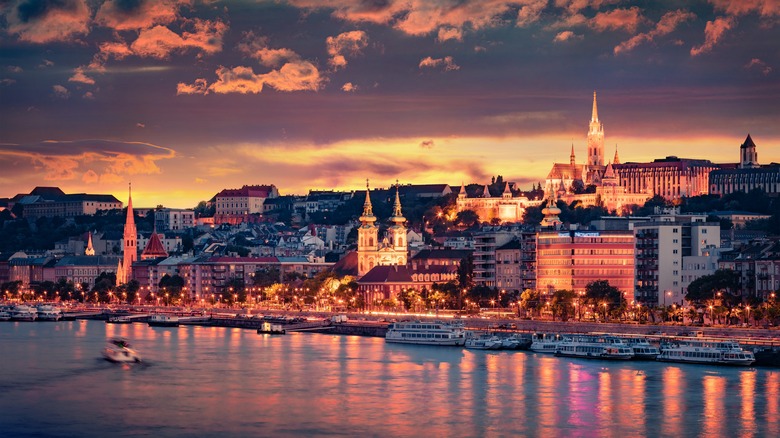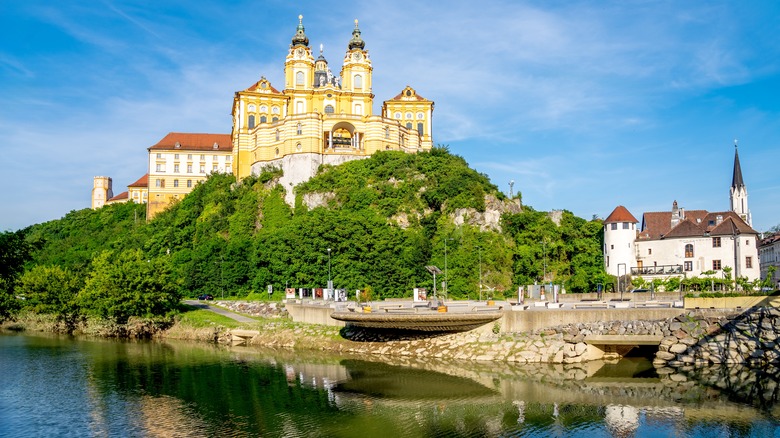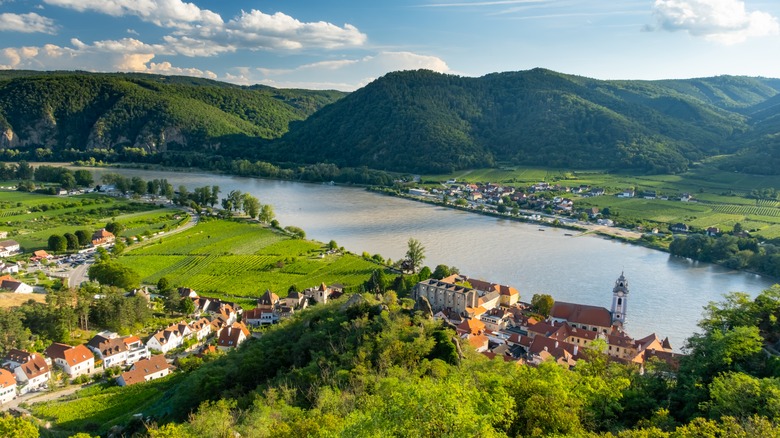One Of The World's Best River Cruises Is A Romantic European Escape Perfect For First-Timers
When you imagine taking a cruise, you might think of exploring private Caribbean islands on a huge cruise ship. While those certainly have their place, it can be a bit intimidating to contemplate sailing the high seas with thousands of people, especially for first-time cruisers. If you're looking for something more intimate that still offers lots to do and see, consider booking a European cruise and put the Danube River at the top of your list. You can expect to see historic castles, picturesque countryside vistas, and grand cities as you go.
Spanning some 1,770 miles, the Danube is the second-longest river in Europe, running from western Germany all the way to the Black Sea. It passes through 10 countries and the capital cities of Vienna, Bratislava, Budapest, and Belgrade. A cruise on the Danube can take between two and three weeks if you do the whole thing. However, if it's your inaugural cruise, you might be more comfortable with a shorter itinerary that tackles just one section of the historic river. If you fall in love with the lifestyle, you can always come back for more!
The most popular route is along the Upper Danube, between Hungary and Germany, which takes around a week. Typically, the cruise will start (or end) in Budapest, toward the middle of the river, and end (or start) in Regensburg or Nuremberg. All three cities feature impressive medieval architecture.
Danube River cruises spotlight history, culture, and food
Highlights of a Danube River cruise range from the historic and the musical to the delicious. The small Austrian village of Dürnstein, with its iconic pale blue clock tower, is where King Richard the Lionheart was imprisoned in the 1190s. The Wachau Valley, a UNESCO World Heritage Site, is home to a number of idyllic vineyards known for producing world-class dry white wines. The region's Melk Abbey is visited by over half a million people each year, and its distinct yellow color, twin towers, and 200-foot-tall dome have made it a landmark along the Danube River for hundreds of years.
Then there's Vienna, the "City of Music." Classical composers like Haydn, Mozart, and Beethoven lived and worked there, and it's home to the legendary Vienna State Opera and Vienna Boys Choir. The city's also got some beautiful palaces and cathedrals. Vienna is the place to try traditional wiener schnitzel, a pan-fried, breaded cutlet.
In Passau, near the border of Austria and Germany, the ornately decorated baroque St. Stephen's Cathedral has a massive organ with nearly 18,000 pipes. While in Passau, sample the famous pralines, chocolate, and gingerbread from Simon Confiserie. From Linz, Austria (depending on the cruise line), you can arrange a side trip to Salzburg, where "The Sound of Music" was filmed and where you can enjoy sensational desserts like Salzburger Nockerl at Café Mozart, a longtime center of Viennese coffeehouse culture.
Choose your Danube River cruise based on the time of year and the ship's amenities
Several cruise lines offer tours of the Danube, each with unique onboard experiences, shore excursions, durations, and price points. Cruising with the Riverside Mozart means enjoying a luxury ship where every room is a suite, and a butler is available to help attend to your every need. There's also a spa and sauna on board. Viking River Cruises provides a number of itineraries, including the "Romantic Danube" cruise, which lasts eight days. Along the way, you can learn to waltz in Vienna, tour the countryside via e-bike, and discover how to make apricot dumplings.
While you could visit many of these places via train or car, when you do it on a river cruise, you aren't packing and unpacking your suitcase for each stop, and you don't have to figure out directions. You basically get to just sit back and enjoy. And unlike crowded Caribbean cruises, river cruise ships are spacious yet intimate, serving fewer than 200 passengers. While there are options to cruise the Danube River pretty much year-round, the best times, when it comes to weather and crowds, are spring and fall – though November and December can be great if you want to visit some European Christmas markets.


